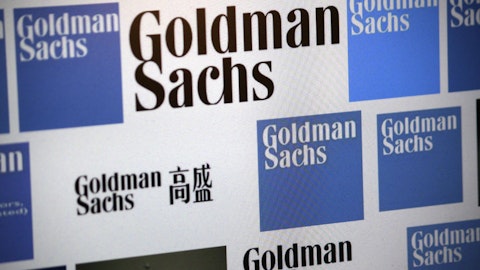Lloyds Banking Group plc (NYSE:LYG) Q4 2023 Earnings Call Transcript February 22, 2024
Lloyds Banking Group plc isn’t one of the 30 most popular stocks among hedge funds at the end of the third quarter (see the details here).
Charles Nunn: Good morning, everyone, and thanks very much for joining us at our 2023 full year results presentation. In line with prior results, I’ll begin with a short overview of the group’s financial and strategic performance. William will then provide the usual detail on our financials. Following a brief summary, we’ll then take your questions. Let me begin on Slide 3. I’m really pleased with the progress we’ve made on implementing our customer-focused strategy, whilst at the same time, delivering strong outcomes for our shareholders. Now there are lots of moving parts in Q4 that William will talk through shortly. But underlying that, the business has performed strongly. With that in mind, I’d like to highlight the following 3 things.
Firstly, we’ve now completed the second year of our strategic transformation and are generating real business momentum. We remain on track to meet our strategic targeted outcomes. Secondly, we’ve met or exceeded the guidance that we laid out during the year, whilst taking proactive action to address a number of headwinds. Our financial performance has enabled increased capital returns of £3.8 billion in the year. And finally, we’re confident of delivering higher, more sustainable returns for shareholders. Importantly, we are reiterating both our returns and capital generation for 2024 and 2026. Turning now to Slide 4, where I will highlight how we’ve delivered for all stakeholders in 2023. We have provided proactive and targeted support during a period of ongoing uncertainty for our customers.

For example, we’ve contacted more than 15 million customers in 2023 to increase awareness regarding savings options and enhanced propositions. Off the back of this, more customers trusted us with their savings, with balances actually growing in the year. We’ve also used our data insights to contact around 7.5 million customers offering support where required. Alongside this, our purpose-driven strategy is focused on building a more inclusive society. To this end, we’ve provided further support to first-time buyers and the social housing sector. Those are both part of a multiyear commitment that combined totals nearly £100 billion of support since 2018. Finally, supporting the transition to a low carbon economy and creating a more sustainable future remains of great importance.
Linked to this, we are increasing our commercial banking sustainable financing target to £45 billion by 2026. Combined, these actions are representative of the strength of our purpose, helping Britain prosper, which enables us to successfully deliver for all stakeholders and deliver profitable growth for the business. On Slide 5, let me now address how we delivered for our shareholders with a brief overview of some of the key financial and nonfinancial metrics. William will take you through the detail later, but we have delivered a robust financial performance in line with both our expectations and the guidance we provided. This is despite some difficult unexpected headwinds, combined with an uncertain external environment. Net income growth of 3% was supported by growth in both net interest income and other operating income.
Combined with disciplined operating costs and strong asset quality, the group delivered a return on tangible equity of 15.8% for the year. This translated into strong capital generation of 173 basis points even after the impacts of regulatory headwinds and a provision relating to the FCA review of Motor Finance Commission arrangements. Excluding these exceptional items, our underlying capital generation was significantly stronger in excess of 200 basis points. This enabled total capital return of £3.8 billion, equivalent to around 14% of the group’s market capitalization. This includes a 15% increase in the ordinary dividend as well as a share buyback of up to £2 billion. To pause briefly on the FCA motor finance review, as you will have seen, we have taken a charge of £450 million.
See also 12 Best Marijuana Stocks To Invest In and 25 Best Zoos in the US.
Q&A Session
Follow Lloyds Banking Group Plc (NYSE:LYG)
Follow Lloyds Banking Group Plc (NYSE:LYG)
However, the extent of misconduct and customer loss, if any, remains unclear. We therefore welcome the independent intervention from the regulator to help ensure clarity for the industry and our customers on these issues. Finally, with regards to nonfinancial performance, we continue to see strong business momentum, including a further increase in our leading levels of digital engagement with 21.5 million users now digitally active comfortably surpassing our 2024 targets. To build on this, I’ll provide more detail on our strategic progress, starting with Slide 6. We’ve now completed the second year out of our 5-year transformation with just 1 year to go to deliver the interim 2024 actions. Our progress has been made possible by an ongoing commitment to investment.
We’ve now delivered more than £2 billion of incremental strategic investment with £1.3 billion invested in 2023. We’re delivering continued momentum across our strategic initiatives. We remain on track to deliver the majority of our 2024 strategic objectives with 20% currently tracking ahead of plan. Whilst we have a small proportion that are currently behind schedule, in part due to changes in the external environment, that is to be expected in a strategic transformation as significant as ours. Encouragingly, our strategic delivery is translating into positive financial benefits. We’ve now realized around £0.5 billion of additional strategic revenues and £0.7 billion of gross cost savings. These provide us with the confidence that we will deliver the targeted financial benefits in both 2024 and 2026.
This includes a return on tangible equity of greater than 15% and capital generation of more than 200 basis points in 2026. On Slide 7, I’ll provide a few examples of strategic delivery in 2023. Our consumer business is the largest contributor to our additional revenues from strategic initiatives. As you heard in our first investor seminar in October, this is an area where we’re making great progress. In addition to the growing levels of digital engagement I highlighted previously, we have grown in areas that we see as attractive, including sustainable mortgages and financing and leasing for electric and hybrid electric vehicles. The latter has been supported by the highly complementary and successful acquisition of Tesco, which is delivering benefits well ahead of our expectations.
We also have several exciting consumer proposition developments in the pipeline for 2024. This includes our innovative embedded finance e-commerce proposition, which we are currently putting in place agreements with key merchants. Our mass affluent business is growing both customer numbers and banking balances. We’re also improving our investment offering for this customer group through a new service called Ready-Made Investments. You’ll hear more about our progress and plans in this space in our next strategy seminar, which takes place in March. Now turning to our progress on the commercial initiatives on Slide 8. Our commercial priorities are split across our SME and CIB businesses. In SME, we remain focused on digitizing our offering and growing in underrepresented areas.
For example, we were the first to launch a combined business current account and merchant services proposition in a new mobile-first origination journey for clients. This has driven a reduction in account opening times of up to 15x as well as supporting more than 20% growth in new merchant services clients for the second year in a row. In CIB, we are investing for growth across our cash debt risk management offering. And in 2023, exceeded our strategic target of £15 billion of sustainable financing. We’re increasing our focus on our award-winning transaction banking business and across our uniquely positioned markets franchise, delivering more than 20% growth in other operating income relative to 2021, in line with our strategic target. This is supporting capital-light revenue diversification for the group.
I’ll now briefly cover our enablers on Slide 9. Our enablers are focused on ensuring that our growth priorities are delivered alongside a business that is more cost efficient and less capital intensive with modern capabilities that are fit for the future. With regard to cost efficiency, we have continued to transform our physical footprint, further improving the efficiency within our distribution network and delivering ongoing reductive — reductions in our office spaces. At the same time, we’re progressively modernizing our technology estate and improving our ways of working to increase the pace and efficiency of change. These activities position us well to deliver the 2024 gross cost savings target of circa £1.2 billion. We’ve also taken proactive action to improve capital efficiency, for example, through the optimization initiatives and the elimination of our pension deficit.
I’ll now close on Slide 10. So as you can see, we continue to make strong strategic and financial progress as we head towards the end of the first phase of our 5-year transformation. We’re reinforcing the strength of our franchise by growing and deepening relationships with customers right across the group. Our progress to date increases our confidence in delivering our strategic initiatives as well as realizing the associated financial benefits. In turn, this will produce higher, more sustainable returns and capital generation for shareholders. Thanks for listening. I’ll now hand over to William for the financials.
William Chalmers: Thank you, Charlie. Good morning, everyone, and thanks again for joining. Let me now provide an overview of the financials on Slide 12. The group delivered a robust financial performance in 2023, meeting our guidance and demonstrating a resilient franchise. Statutory profit after tax was £5.5 billion, with a return on tangible equity of 15.8%. Net income of £17.9 billion was up 3%, supported by a higher net interest margin of 311 basis points, in line with guidance and 10% growth in other income. This was partially offset by a higher operating lease depreciation charge, reflecting growth in lower used car prices. We continue to manage costs tightly. Operating costs were £9.1 million, in line with guidance and up 5% year-on-year.
This was driven by higher planned strategic investments, including elevated severance charges, new business costs and ongoing inflationary pressures. Asset quality is strong. The impairment charge of £308 million includes a significant write-back as well as the impact of an improved economic outlook. Excluding these, the asset quality ratio would have been 29 basis points, still in line with our guidance. Tangible net assets per share, 50.8p were up 4.3p in 2023, including 3.6p in the fourth quarter. This performance resulted in strong capital generation of 173 basis points, again, in line with guidance and after significant regulatory headwinds. Strong capital generation enabled an increased total capital return of £3.8 billion. This includes a 2.76p per share total dividend, up 15% year-on-year and a share buyback program of up to £2 billion.
Let me now turn to Slide 13 to look at the development of our customer franchise. Our customer franchise is resilient. Total lending balances stood at £450 billion, down 1% on the prior year, including £2 billion in the fourth quarter. Notably, the year-on-year movement includes securitizations of over £5 billion of legacy mortgages and unsecured loans. Excluding these, lending balances were stable on the year. Focusing on the fourth quarter. Mortgages were down slightly, but with the growth in the open book. There was modest growth in consumer finance, excluding the £2.7 billion securitization. Commercial Banking was down £2.9 billion in the quarter. This included £0.5 billion of repayments of government-backed lending within the small and medium business enterprise.
On the liability side, total deposits were down 1% in 2023 as a whole, however, up more than £1 billion in Q4. Deposit churn appears to be slowing. In the fourth quarter, retail current accounts were down £1.9 billion compared to £3.2 billion in Q3. This was more than offset by savings inflows of almost £4 billion, again with slowing churn evident in the mix. In the commercial franchise, deposits were down £0.9 billion in Q4, predominantly within small and medium businesses. And in insurance, pensions and investments, we saw 8% growth in assets under administration in the fourth quarter. Moving on to Slide 14, net interest income. NII of £13.8 billion was up 5% on the prior year. Q4 was down 4% quarter-on-quarter. Average interest earning assets of £453 billion were up slightly compared to 2022, with the fourth quarter broadly stable.
Full year margin was up 17 basis points from 2022 at 311 basis points, in line with our guidance for greater than 310 basis points. This benefited significantly from the annualized impact of base rate changes as well as continued structural hedge reinvestment. Together, these outweighed pressures from mortgage pricing and deposit mix change. The Q4 margin of 298 basis points was down 10 basis points compared to Q3, a touch more than we expected. This reflects lower PCA balances through most of the quarter, a higher-than-expected reduction in noninterest-bearing deposits in the commercial bank and mortgage pressures driven by swaps volatility. Nonbanking net interest income was £311 million, including a further £80 million in Q4. This is up significantly compared to the prior year.
It is likely to continue to grow, albeit at a slower pace in 2024. Looking forward, we now expect average interest-earning assets to be above £450 billion in 2024. This implies a modest reduction year-on-year, driven by growth in the core business being offset by reductions in the SVR mortgage book and repayments of government support scheme loans in commercial. Alongside, we now expect the net interest margin to be greater than 290 basis points this year. Within this, we’ll see further pressure from mortgage book refinancing and ongoing deposit churn, albeit both of these headwinds are expected to ease throughout 2024. In the other direction, structural hedge provides a continued tailwind. Our assumption of 3 bank base rate reductions in 2024, starting in June, is obviously an important input to this guidance.
Let me now turn to Slide 15 to look at the mortgage book. The open mortgage book fell by £1.1 billion in 2023, growing in the second half, including modestly in the fourth quarter. Strong customer retention in fixed rate products was offset by the roll-off from the SVR book. Our market share demonstrated resilience in what was a slow market environment. The group margin continues to be impacted by the difference between new and maturing mortgage spreads. While pricing remained competitive in the fourth quarter, the market has slightly strengthened. Completion margins were around 60 basis points, slightly higher than we saw in Q3. And looking forward, as we move through the year, margins on maturing mortgages will reduce gradually. This means the mortgage pricing headwind is abating through 2024 and into 2025.
The expectation is for modest growth in the open mortgage book across the year. This is supported by strong customer retention and a slightly improving net lending market. Let me now turn to our other asset books on Slide 16. Excluding the impact of securitizations, we saw a solid performance in our other lending portfolios. Combined balances for U.K. cards, unsecured loans and motor were up £2.7 billion in 2023, again, excluding the securitization activity. In Q4, credit cards were flat. Within this, interest-bearing balances were up slightly based on growth in low-risk customer segments. Motor balances and unsecured lending likewise, were both up slightly. Commercial balance — commercial banking lending was down £5.1 billion in 2023. In the fourth quarter, balances across small and medium businesses were down £1.2 billion, including repayments of government-backed lending.
CIB lending meanwhile fell by £1.7 billion, reflecting a disciplined approach to lending in the context of growing income streams. Let’s move to the other side of the balance sheet on Slide 17. Deposit performance was robust over the year. Total customer balances of £471 billion were down £4 billion or 1% in 2023, but up £1 billion in Q4. Retail deposits ended the year at £308 billion. Over the year, we recaptured a significant proportion of the current account outflows within our own savings proposition. Indeed, our retail savings accounts were up £12 billion in 2023, including £4 billion in the fourth quarter. This performance was driven by enhanced propositions and proactive customer communications. As I said, we’re now seeing deposit churn in the retail business slowdown.
The switch into fixed-term savings accounts from Instant Access in Q4, for example, was materially less than we saw in Q3. Commercial deposits are down £1 billion in both 2023 and Q4. This was driven by customers reducing balances primarily in the SMB business, partially offset by targeted growth in the CIB franchise. Going forward, based on the current rate outlook, we expect deposit mix shift to continue to slow gradually in 2024. Let me now turn to the structural hedge on Slide 18. Structural hedge notional ended the year at £247 billion. This includes a £4 billion reduction in Q4, in line with our expectations for a modest notional reduction in the second half. The weighted average duration of the hedge remains around 3.5 years. As you know, we manage structural hedge prudently.
Given the slowing deposit churn we expect in 2024, we’re planning for a further modest reduction in the notional balance this year, stabilizing in the second half. We have around £40 billion of maturities during the year, which gives us significant flexibility in our hedge management. In 2023, hedge income was £3.4 billion, £0.8 billion than the prior year. Looking forward, we expect this to be around £0.7 billion higher this year given the continued benefit from rolling the hedge into higher swap rates. Indeed, the refinancing of the hedge remains a powerful driver of income growth for the foreseeable future. Moving to other income on Slide 19. Other income of £5.1 billion was 10% higher than 2022, driven by growth across the businesses.
Retail saw an improved current account and credit card performance in the context of recovering activity as well as a growing motor contribution. Commercial saw growth in markets and bond financing based on increased market shares. Meanwhile, IP&I other income was up 26% year-on-year. This included the benefit from the strong new business levels, income releases from a higher contractual service margin and improved general insurance performance. Looking forward, we expect gradual progress in other income driven by higher levels of activity and the realization of our strategic initiatives. Turning to operating lease depreciation. £956 million is a significantly higher charge year-on-year. The increase is driven by 2 factors: Firstly, volumes are continuing to grow in the motor leasing business, driven by organic growth and the acquisition of Tesco.
Secondly, after a period of outperformance, used car prices have fallen including a particular decline in the fourth quarter. This has resulted in a normalization of the depreciation expense as well as an additional nonrun rate charge of around £100 million taken in Q4 to restock our forward-looking provision given used car price falls. Looking forward, you should, therefore, expect the quarterly charge to be roughly the Q4 run rate level plus organic growth but excluding the £100 million provision restock. Moving on, let me talk about our continued focus on efficiency on Slide 20. Operating costs of £9.1 billion are again in line with guidance. This was up 5% from the prior year, driven by planned investments, the costs associated with new business and inflation.
Q4 was impacted by investment, including additional severance and as usual, the bank levy. We’ll continue to manage the cost base tightly. We now expect 2024 operating costs to be £9.3 billion, slightly higher than our original expectation. This in turn, is due partly to higher inflation than expected, but mainly due to higher severance payments that will improve efficiency over time. The £9.3 billion is net of achieving our £1.2 billion of cost saves as we continue to successfully absorb material inflationary pressure. It’s worth noting here that our operating cost guidance does not include the potential for a net neutral charge of around £100 million. This is driven by a sector-wide change to the way in which the Bank of England charges for supervisory costs.
And if it is enacted, this will result in an equivalent offsetting gain in net interest income. Remediation costs in the year increased to £675 million. This is principally due to the £450 million provision for the potential impact of the FCA review into historical motor finance commissions. This provision reflects estimates for operational and legal costs. It also reflects an assessment of potential redress based upon a range of scenarios. To be clear, there remains significant uncertainty and the financial impact could differ materially from the amount that we have provided. We welcome the independent FCA intervention to help ensure that we get to the right outcome. Looking now at asset quality on Slide 21. Asset quality remains strong across the group.
The impairment charge of £308 million reflects the resilience of our prime customer base and our prudent approach to risk. Alongside, we experienced a significant write-back in Q4. Furthermore, the charge includes an MES release of £257 million from forecast adjustments to reflect the slightly improved economic outlook. Excluding the write-back and the updated economic forecast, the asset quality ratio was 29 basis points, which is still in line with our guidance. The Q4 impairment charge was a net credit of £541 million, again, excluding the write-back in MES release, the charge was stable quarter-on-quarter. The stock of ECL on the balance sheet now stands at £4.3 billion. This remains above prepandemic levels, reflecting uncertainties in the economic outlook.
Given the ongoing resilience of the portfolio, we expect the asset quality ratio to be less than 30 basis points in 2024. Let me now turn to Slide 22 to look at our economic assumptions in more detail. We have made modestly positive revisions in our updated economic outlook. We believe GDP growth will be subdued this year. However, we now expect inflation to fall more sharply. This will allow 3 base rate cuts in 2024 from the current 5.25% level starting in June. Our HPI outlook has improved since our last estimate. We now expect only a slight fall of around 2% this year, helped by a lower rate environment. Meanwhile, unemployment is expected to remain low, peaking at 5.2% in Q4 2024. As usual, we present the full set of economics and associated ECL provisions in our appendix.
Moving on, let me turn to Slide 23 to look at our credit performance. Performance across our portfolios continues to be resilient. In particular, [indiscernible] arrears in U.K. mortgages were stable throughout 2023, after increasing slightly at the start of the year. As mentioned before, this trend was largely driven by new to arrears in the ’06 to ’08 legacy book. Meanwhile, arrears and defaults in the unsecured book continue to be very stable, remaining similar to or below prepandemic levels. Alongside, early warning indicators in retail remain reassuring. Credit quality in the commercial book also remains resilient. Likewise, early warning indicators are healthy. Our commercial portfolio is high quality. Around 90% of SME lending is secured and more than 80% CIB exposure is to investment-grade clients.





